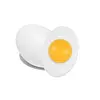What's inside
What's inside
 Key Ingredients
Key Ingredients

 Benefits
Benefits

 Concerns
Concerns

No concerns
 Ingredients Side-by-side
Ingredients Side-by-side

Lactococcus/Hyaluronic Acid Ferment Filtrate
Sodium Hyaluronate
HumectantHydrolyzed Hyaluronic Acid
HumectantSodium Acetylated Hyaluronate
HumectantWater
Skin ConditioningButylene Glycol
HumectantGlycerin
HumectantPPG-10 Methyl Glucose Ether
Skin ConditioningDisodium Succinate
MaskingHydroxyethylcellulose
Emulsion StabilisingSuccinic Acid
BufferingPentylene Glycol
Skin ConditioningDipropylene Glycol
HumectantDiglycerin
HumectantPhenoxyethanol
PreservativeDisodium EDTA
Lactococcus/Hyaluronic Acid Ferment Filtrate, Sodium Hyaluronate, Hydrolyzed Hyaluronic Acid, Sodium Acetylated Hyaluronate, Water, Butylene Glycol, Glycerin, PPG-10 Methyl Glucose Ether, Disodium Succinate, Hydroxyethylcellulose, Succinic Acid, Pentylene Glycol, Dipropylene Glycol, Diglycerin, Phenoxyethanol, Disodium EDTA
Water
Skin ConditioningGlycerin
HumectantPropylene Glycol
HumectantQuaternium-60
Carbomer
Emulsion StabilisingGlyceryl Polyacrylate
Vaccinium Myrtillus Fruit Extract
Skin ConditioningSaccharum Officinarum Extract
MoisturisingAcer Saccharum Extract
Skin ConditioningCitrus Aurantium Dulcis Fruit Extract
MaskingCitrus Limon Fruit Extract
MaskingDipropylene Glycol
HumectantAcmella Oleracea Extract
Skin ProtectingEgg Yolk Extract
EmulsifyingHydrolyzed Egg Shell Membrane
HumectantCellulose
Absorbent1,2-Hexanediol
Skin ConditioningEgg Shell Powder
AbrasiveVinegar
Disodium EDTA
Caprylyl Glycol
EmollientCaprylhydroxamic Acid
Phenoxyethanol
PreservativeParfum
MaskingWater, Glycerin, Propylene Glycol, Quaternium-60, Carbomer, Glyceryl Polyacrylate, Vaccinium Myrtillus Fruit Extract, Saccharum Officinarum Extract, Acer Saccharum Extract, Citrus Aurantium Dulcis Fruit Extract, Citrus Limon Fruit Extract, Dipropylene Glycol, Acmella Oleracea Extract, Egg Yolk Extract, Hydrolyzed Egg Shell Membrane, Cellulose, 1,2-Hexanediol, Egg Shell Powder, Vinegar, Disodium EDTA, Caprylyl Glycol, Caprylhydroxamic Acid, Phenoxyethanol, Parfum
 Reviews
Reviews

Ingredients Explained
These ingredients are found in both products.
Ingredients higher up in an ingredient list are typically present in a larger amount.
Dipropylene Glycol is a synthetically created humectant, stabilizer, and solvent.
This ingredient helps:
Dipropylene glycol is technically an alcohol, but it belongs to the glycol family (often considered part of the ‘good’ alcohols). This means it is hydrating and gentle on skin unlike drying solvent alcohols like denatured alcohol.
As a masking agent, Dipropylene Glycol can be used to cover the smell of other ingredients. However, it does not have a scent.
Studies show Dipropylene Glycol is considered safe to use in skincare.
Learn more about Dipropylene GlycolDisodium EDTA plays a role in making products more stable by aiding other preservatives.
It is a chelating agent, meaning it neutralizes metal ions that may be found in a product.
Disodium EDTA is a salt of edetic acid and is found to be safe in cosmetic ingredients.
Learn more about Disodium EDTAGlycerin is already naturally found in your skin. It helps moisturize and protect your skin.
A study from 2016 found glycerin to be more effective as a humectant than AHAs and hyaluronic acid.
As a humectant, it helps the skin stay hydrated by pulling moisture to your skin. The low molecular weight of glycerin allows it to pull moisture into the deeper layers of your skin.
Hydrated skin improves your skin barrier; Your skin barrier helps protect against irritants and bacteria.
Glycerin has also been found to have antimicrobial and antiviral properties. Due to these properties, glycerin is often used in wound and burn treatments.
In cosmetics, glycerin is usually derived from plants such as soybean or palm. However, it can also be sourced from animals, such as tallow or animal fat.
This ingredient is organic, colorless, odorless, and non-toxic.
Glycerin is the name for this ingredient in American English. British English uses Glycerol/Glycerine.
Learn more about GlycerinPhenoxyethanol is a preservative that has germicide, antimicrobial, and aromatic properties. Studies show that phenoxyethanol can prevent microbial growth. By itself, it has a scent that is similar to that of a rose.
It's often used in formulations along with Caprylyl Glycol to preserve the shelf life of products.
Water. It's the most common cosmetic ingredient of all. You'll usually see it at the top of ingredient lists, meaning that it makes up the largest part of the product.
So why is it so popular? Water most often acts as a solvent - this means that it helps dissolve other ingredients into the formulation.
You'll also recognize water as that liquid we all need to stay alive. If you see this, drink a glass of water. Stay hydrated!
Learn more about Water